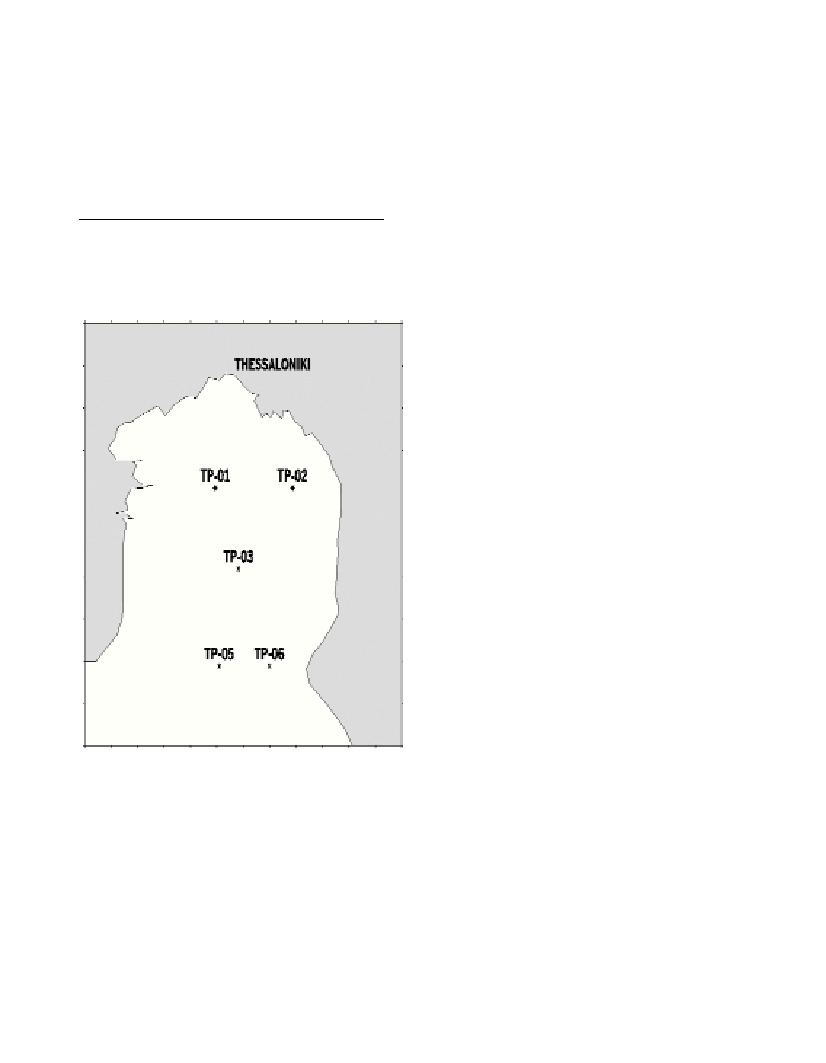Rapp. Comm. int. Mer Médit., 37,2004
232
TROPHIC CONDITIONS AND TRENDS IN NUTRIENT CONCENTRATIONS IN THESSALONIKI BAY
A. Pavlidou*, R. Psyllidou-Giouranovits
Hellenic Center for Marine Research, PO Box 712, GR 190 13, Anavyssos, Attica, Greece - *aleka@ncmr.gr
Abstract
In this paper we present the results of nutrient measurements during the period 1995-2002, in order to define the ecological status of
Thessaloniki Bay ecosystem.
This work contains an assessment of the eutrophication of coastal waters in?uenced by a sewage outfall in Thessaloniki Bay, for the period
1995-2002. A eurtophication scale has been applied for indicating four trophic levels in the marine environment (oligotrophic, lower
mesotrophic, upper mesotrophic, eutrophic).
Keywords: Thessaloniki Bay, Eutrophication, Trophic Status.
Introduction
The study area is mainly affected by aquaculture activities,
agriculture activities in the coastal zone and pollutants from the
domestic and industrial effluentsof Thessaloniki (partly treated).
Sampling sites are shown in Figure 1.
Materials and methods
Nutrient data (nitrate, nitrite, silicate, ammonium and phosphate)
have been collected during the period 1995-2002 (1,2).
The samples for the determination of nutrients were collected in
100 ml polyethylene bottles and kept continuously under deep freeze
(-20 °C), until their analysis in the laboratory by a nutrient
autoanalyser (3,4,5,6).
Results and discussion
During the period 1995-2002 the mean integrated nutrient
concentrations in Thessaloniki Bay ranged as follows: Phosphate:
0.09 – 1.23 µmol/L; Silicate: 0.54 – 9.17 µmol/L; Nitrite: 0.04 – 1.55
µmol/L; Nitrate: 0.20 – 2.87 µmol/L; Ammonium: 0.08 - 4.14 µmol/L.
The temporal variability of nutrient concentrations in the study area
is related with the Thessaloniki municipal sewage outfall, the
agriculture and aquacultute activities in the area, the existence of the
thermocline during the warm period, the enhanced anthropogenic
activities and the various point sources, which enrich the study area in
pollutants, as well as the ?uctuation of the ?ow rate of the main rivers
affecting the study area.
The characterisation of the trophic level of the Thessaloniki bay is
based on nutrient concentration scales evaluated for the greek coastal
ecosystems (7). According to the mean integrated values of nutrients
for the period 1995-2002, Thessaloniki Bay is characterised as an
upper mesotrophicarea.
Additionally, the stoichiometric balance criterion in the selected
stations confirmed that the mean ratio for the nutrients calculated does
not reach the Redfield ratio
?
N:P of 16:1. The development of the
?
N:P ratio indicates that during the last ten years nitrogen was
developed towards the limiting nutrient in the area studied.
References
1-Pavlidou, A., 2001. Dissolved Oxygen and nutrients in the inner
Thermaikos Gulf. December 1999-November 2000. Proccedings of the 7
th
Conference of Chemistry Greece-Cyprus, pp. 49-51, Lefkosia, Cyprus.
2-Pavlidou, A. and Psilldou-Giouranovits, R., 2003. Monitoring of the
temporal and spartial distribution of dissolved oxygen and nutrients in the
Thermaikos Gulf”. Proceedings of the 7
th
Hellenic Conference in
Oceanography and Fishing, p. 252, Chersonissos, Krete, Greece.
3-Koroleff, F., 1970. Revised version of “Direct determination of
ammonia in natural waters as indophenol blue”. Int. Con. Explor. Sea C.
M. 1969/ C:9 ICES information on techniques and methods for sea water
analysis. Interlab. Rep., 3: 19-22.
4-Mullin, J.B., Riley, J.P., 1955. The colorimetric determination of
silicate with special reference to sea and natural waters. Anal. Chim. Acta,
12:162-176.
5-Murphy,J., Riley, J. P. (1962). A modified single solution method for
phosphate in natural waters. Anal. Chim. Acta.,1: 162-176.
6-Strickland, J.D.H., Parsons, T.R., 1968. A practical handbook of sea
water analysis. Bull. Fish. Res. Bd. Canada,167: 310.
7-Karydis, M., 1999. Evaluation of the trophic levels in greek coastal
ecosystems. Scientific Report, Univ. of Aegean, Lesvos Island, February
1999.

